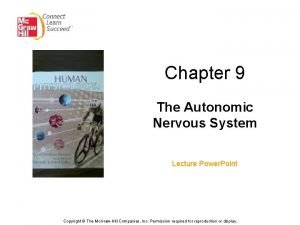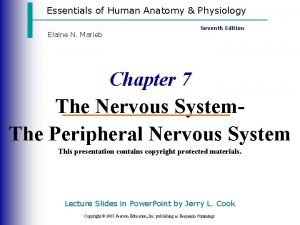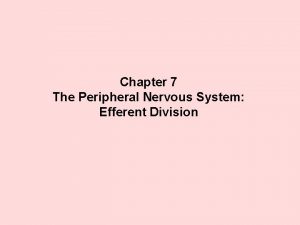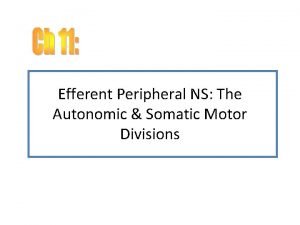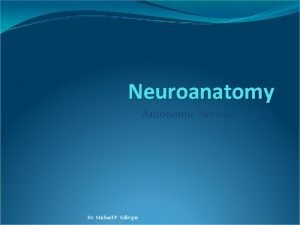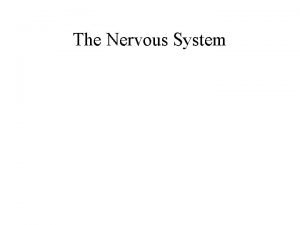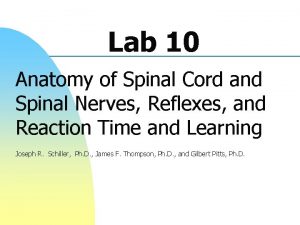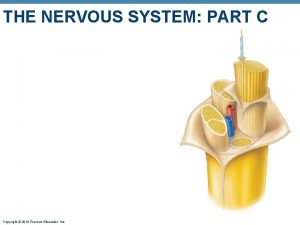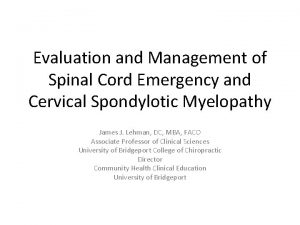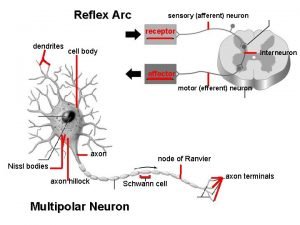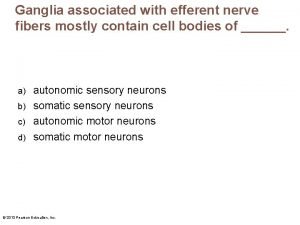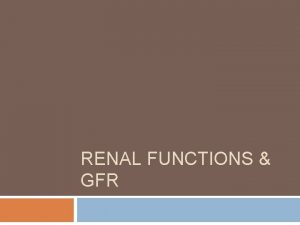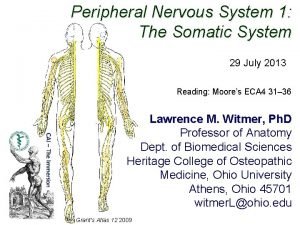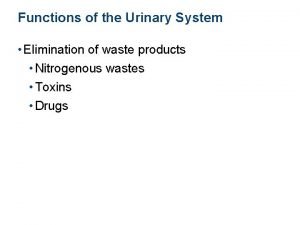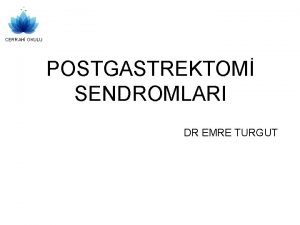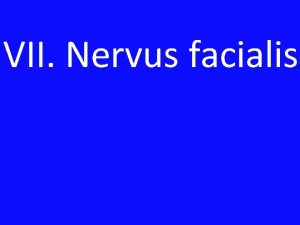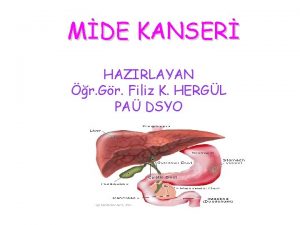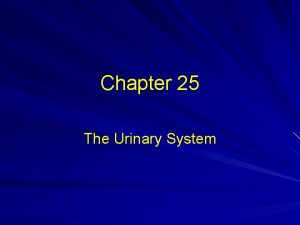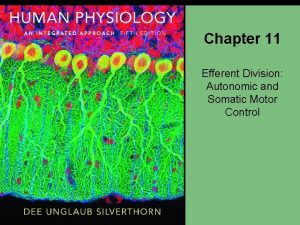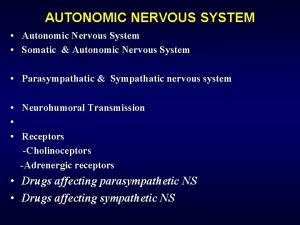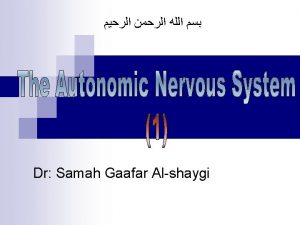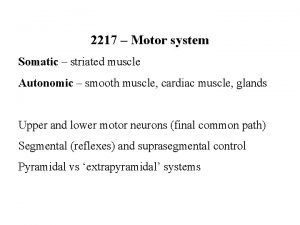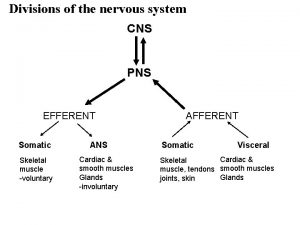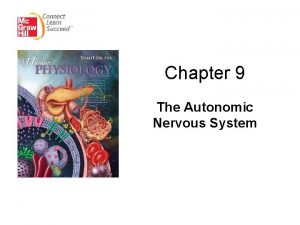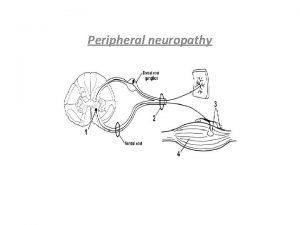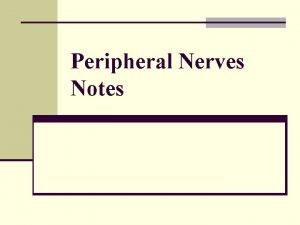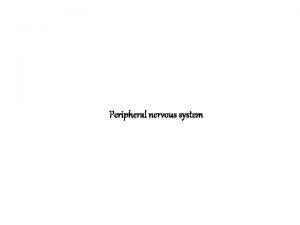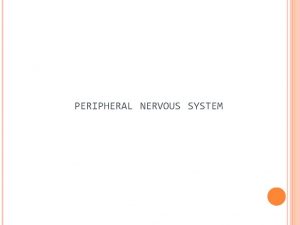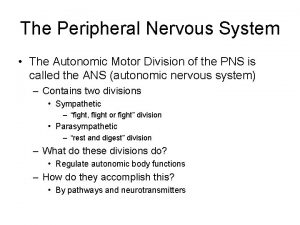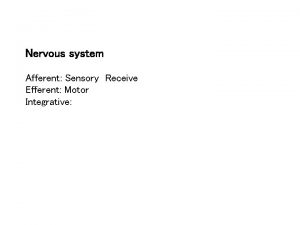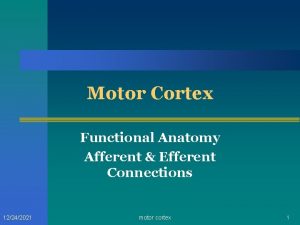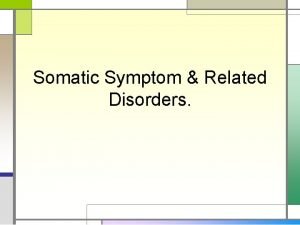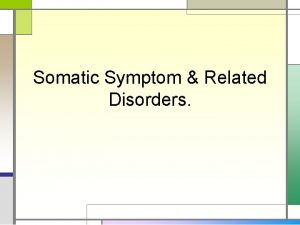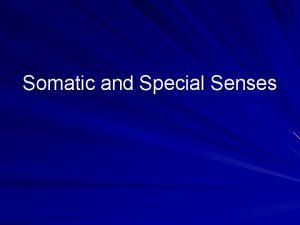Efferent Peripheral NS The Autonomic Somatic Motor Divisions























- Slides: 23

Efferent Peripheral NS: The Autonomic & Somatic Motor Divisions


Homeostasis and the Autonomic Division • BP, HR, Resp. , H 2 O balance, Temp. . . • Mostly dual reciprocal innervation • Sympathetic: flight-or-fight • Parasympathetic: rest and digest

Autonomic pathway: 2 Efferent Neurons in Series Preganglionic neuron cell body in CNS Synapsis in autonomic ganglion outside CNS divergence Postganglionic neurons target cells?

= Thoracolumbar division (T 1 to L 2) ® Preganglionic neurons from thoracolumbar region of spinal cord ® Pre and paravertebral ganglia ® Long postganglionic axons secrete NE onto adrenergic receptors

= Craniosacral Division ® Long preganglionic axons from brain & S 2 - S 4 ® Intramural ganglia ® Postganglionic neurons secrete Ach onto cholinergic muscarinic receptors

Most Common Autonomic NTs: • Acetylcholine (ACh) ACh neurons & ACh receptors are called cholinergic (nicotinic or muscarinic). Located at autonomic preganglionic & parasympathetic postganglionic synapses • Norepinephrine (NE) NE neurons & receptors are called (nor) adrenergic ( and ). Located at sympathetic postganglionic synapses Fig 11 -7

NTs of Autonomic NS Compare to Fig 11 -7 and β

Neuroeffector Junction of ANS = Synapse between postganglionic cell and target organ Most are different from model synapse: Axon has varicosities containing neurotransmitter (compare to Fig 8 -20, p. 270) Fig 11 -8

Varicosity of Sympathetic Neuron Fig 11 -9

Two Types of Cholinergic Receptors: 1) Nicotinic cholinergic receptor • Nicotine = agonist • In autonomic ganglia & somatic NS • Directly opens a Na+ / K+ channel: ? • Curare = antagonist

2) Muscarinic cholinergic receptor • Muscarine = agonist Amanita muscaria • Found in neuro-effector junctions of parasympathetic branch • G-protein coupled mechanisms • Atropine = antagonist

Muscarinic ACh Receptors are G-protein Mediated Example: Sweat Glands Other examples have more complex with 2 nd messenger mechanisms

Summary: Pre- & Postganglionic Parasympathetic Neurons Release ACh nicotinic muscarinic Receptors

Adrenergic Receptors Found in neuroeffector junctions of sympathetic branch G protein linked, with various 2 nd mess. mech. Receptors: NE > E (most common) Excitation [Ca 2+]in muscle contraction or secretion by exocytosis. Inhibition of GI tract and pancreas

- Receptors Clinically more important – Excitation heart (E = NE) – usually inhibitory: smooth muscle relaxation of some blood vessels and bronchioles (E > NE!) – “ -blockers” = Antagonists (e. g. : Propranolol and metoprolol Toprol-XL)

Termination of NT Activity • ACh esterase Fig 8 -22 • Catecholamine reuptake �repackaging �degradation (MAO) Fig 11 -9

Somatic Motor Division • Pathway consists of single neuron from CNS to target • Neuromuscular junction: nicotinic cholinergic receptors • Always excitatory muscle contracts

Somatic Neuromuscular Junction Fig 11 -13

Agonists and Antagonist of ANS Direct Antagonists �Atropin �Curare muscarinic nicotinic �Propranolol �Metoprolol 1 and 2 1

Indirect (Ant)agonists See Table 11 -3 • Botulinum toxin inhibits Ach release • Neostigmine inhibits Ach. E (organophosphate insecticides, such as para-, malathion) Therapy for MG • Cocaine prevents NE reuptake • Amphetamines stimulate NE release

Also review Tables 11 -1 11 -4 11 -5 A Powerful Addiction

Review Fig 11 -11
 Preganglionic and postganglionic parasympathetic neurons
Preganglionic and postganglionic parasympathetic neurons Autonomic nervous system skeletal muscle
Autonomic nervous system skeletal muscle Nervous system main division
Nervous system main division Somatic and autonomic nervous system
Somatic and autonomic nervous system Cranial nerve mnemonics
Cranial nerve mnemonics Efferent motor neurons
Efferent motor neurons Motor (efferent) division
Motor (efferent) division Autonomic motor neurons regulate visceral activities by
Autonomic motor neurons regulate visceral activities by Parasympathetic
Parasympathetic Somatic motor function
Somatic motor function Somatic motor neuron
Somatic motor neuron Spinal nerves
Spinal nerves Lhermittes sign
Lhermittes sign Somatic motor neuron
Somatic motor neuron Somatic motor function
Somatic motor function Site of somatic motor neuron cell bodies
Site of somatic motor neuron cell bodies Ganglia associated with efferent fibers
Ganglia associated with efferent fibers Renal tubule
Renal tubule Visceral afferent vs efferent
Visceral afferent vs efferent Glomerular capillary
Glomerular capillary Postgastrektomi sendromları
Postgastrektomi sendromları Nuc nervi facialis
Nuc nervi facialis Gavaj enjektörü
Gavaj enjektörü The urinary system consists of
The urinary system consists of
